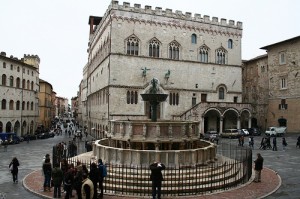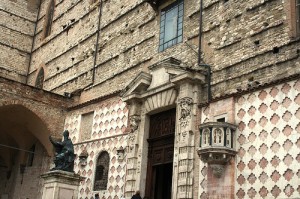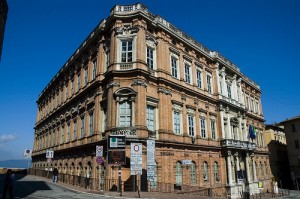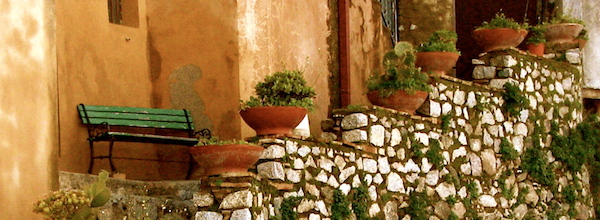Archive for the ‘current events’ Category
Living Deliberately: Knowing When to Turn Off the News
Turning off the news was a major step on my road to simplicity.
Read on...Le Quattro Volte: Cannes Winner Beautifully Describes Calabrian (and Universal) Life — Without Words
Le Quattro Volte (The Four Times), a film set in Calabria by director Michelangelo Frammartino, won the 2010 Europa Cinemas Label as Best European Film in Cannes Directors’ Fortnight. From the trailer and clips I have seen, it beautifully captures the simplicity of life in this gorgeous land I’m proud to call home while effectively relating the universal idea that each of us has “four distinct lives [mineral, vegetable, animal, and man] and so we have to get to know ourselves four times” (my translation from the official trailer below).
The fact that the story revolves around a goatherd isn’t exactly lost on me either.
A description of the film from Tim Lloyd at AdelaideNow:
An old goatherd takes his flock to feed in the high pastures of Calabria then milks them at his stalls at a spectacular hilltop village, where the rhythm and ritual of life appears unchanged in centuries. His cure-all for his failing health is the blessed ash from ceremonies at the local church. He dies, and at his death a newborn goat takes its first breath. It suits the off-beat and curiously satisfying vision of the film, that the goatherd is resurrected as a goat, then as a tree, and eventually as a mineral.
Screen‘s Wendy Mitchell reports on what the jury said:
This is a beautifully evocative, humorous and subtle look at life and nature in deepest rural Italy. Never didactic or sentimental, the director takes creative risks and manages to pull them off. At a time when original film-making is so threatened, we feel it is entirely appropriate to award the Europa Cinemas Label to Le Quattro Volte, and to offer European audiences the opportunity of enjoying such a life-affirming view of a remote corner of our continent.
From Natasha Senjanovic of The Hollywood Reporter:
Frammartino uses his background as a video installation artist to create something that one could just as easily come across playing at an art gallery. The director simply turns on the camera and shows us the natural progression of time in a place where time seems to have stopped. Working from a quote from the School of Pythagoras — that each of us has four distinct lives within our one life, and thus must meet each other four times — the number four also represents four elements (man, animal, plant and mineral) and the four seasons.
I personally find the link with Pythagoras, whose work heavily influenced Plato and other subsequent philosophers, notable as the Ionian Greek philosopher spent a good deal of time in Crotone, Calabria; there he established a small group of followers, which actually may have led to the city’s troubles with nearby Sybaris, now only ruins near the current town of Sibari. Sybarites were famous for their enjoyments of all things luxurious — and they are why we still use the term “sybarites” for pleasure-seekers today — but their lifestyle did not exactly jibe with Pythagoras’ teachings.
What follows are the trailer of Le Quattro Volte, another set of clips, and an interview with Frammartino (in Italian):
I cannot wait to see this film.
Five in Focus: American Expat Bloggers on Italian Movies
In conjunction with the release of George Clooney’s The American, I was one of the American expat bloggers asked by Focus Features to choose the five films I feel sum up Italy for me.
Please click on the screenshot to go see the five films I chose…
and then please come back and let me know what yours are and why in the comments.
And by the way, have you seen The American? What did you think?
P.S. I’ve put up a “Media Buzz” page to gather some of the other places that mention Bleeding Espresso. Have a look see!
Amanda Knox Conviction: Motivazioni della Sentenza
 So far this week, we’ve been through the alleged anti-American bias and so-called media circus in the Amanda Knox murder case.
So far this week, we’ve been through the alleged anti-American bias and so-called media circus in the Amanda Knox murder case.
Quick recap: While it seems many (not all) Knox supporters have backed off the anti-Americanism claim, many still don’t believe the experiences of those of us who live in Italy regarding media coverage. I don’t know why I (and other Americans living in Italy who commented on the post of their own free will) would have any motivation to lie about how much average Italians followed this case in our experience, but there you have it.
My final words on that: Yes, this was a big news story when it broke — the murder of a young girl always is — and it got bigger because of the international angle, making it one of the top stories to come of out of Italy in many years (mostly because let’s be honest — the world normally doesn’t care what happens in Italy). But as far as what average Italians were talking about and paying attention to, this just wasn’t on the radar. I’m sorry if that ruins your image of our morning cappuccino chats, but it’s true.
One thing before we move on regarding comments, though: thank you to everyone who stayed on-topic and gave their viewpoints on the last post. Much appreciated. And to those who commented with obviously false email addresses, you’re spammers to me, so that’s where your comments went. Blatant disregard of my rules will also send your comment to the rubbish bin.
Moving on…
The So-Called Conviction Based on Nothing
I was in in the United States when the Knox and Sollecito verdicts were announced. Following the announcement, I watched as some American commentators trashed the entire Italian criminal justice system because an innocent American girl was railroaded and just convicted on no evidence and all of Italy should be ashamed of itself and harumph! *crosses arms in indignation*
It was a well-crafted and well-executed play on emotions, but unfortunately not entirely based in reality. There was and is evidence on which the court based its decision. In fact, the court has since written it out for everyone to read — in the 400+ pages of the “motivazioni della sentenza,” which we’ll get to in a bit.
Before I get into what is in the decision, let me lay down some disclaimers about this post:
 1. My goal here is mostly to provide those who haven’t been following the case or who haven’t been privy to what is contained in the sentencing report because they don’t read Italian an idea of what the Italian court believed and on what it based Knox’s conviction. From what I’ve read, particularly in the American press, the impression has been given that Knox was convicted based on her behavior and nothing more. This post is to clarify that the factfinders had more before them than just Knox’s behavior.
1. My goal here is mostly to provide those who haven’t been following the case or who haven’t been privy to what is contained in the sentencing report because they don’t read Italian an idea of what the Italian court believed and on what it based Knox’s conviction. From what I’ve read, particularly in the American press, the impression has been given that Knox was convicted based on her behavior and nothing more. This post is to clarify that the factfinders had more before them than just Knox’s behavior.
2. What I am including below is my personal translation of what I consider to be the major pieces of evidence on which Amanda Knox was convicted; there is obviously *much* more to the report, including various theories as to why Knox and Sollecito acted the way they did at different times. Some of those scenarios undoubtedly weighed more heavily into the decision than others (and it’s certainly personal opinion as to whether their scenarios make sense), but I’m focusing on physical evidence and eyewitness testimony, because, again, I don’t think they have been widely reported in English-speaking media.
In other words, I’m really not writing this post for those of you who live and breathe the case, as I’m sure those of you who disagree with the decision have an argument against every piece of evidence below — which by the way is entirely normal in a criminal trial.
3. I’m not addressing the evidence against Raffaele Sollecito or the case against Rudy Guede. This is not an indication that I think either or both of them was rightfully or wrongfully convicted — I’m just not covering it here. They certainly deserve their own posts, but I’m not the one to write them, at least not now.
4. This post will present what the judges wrote. Period. Whether or not you agree with the findings of the court is another matter entirely, and something many of you touched on in your comments throughout the week. You’re likely to get into that again in comments, but I’m not going to be commenting on it.
5. Whether or not I personally would have made the same findings of fact as the court did, I can’t say. In fact, I can’t know because I haven’t read the trial transcripts or have any indication of what witnesses sounded like, etc. I’m sorry I won’t take for granted what “journalists” have written about what went on in court. I just don’t trust either “side” with that information.
 6. Even taking as true every finding of fact by this court, whether or not I personally would have voted to convict Amanda Knox based on the evidence the court accepted is not in discussion — and this is closely related to the previous point.
6. Even taking as true every finding of fact by this court, whether or not I personally would have voted to convict Amanda Knox based on the evidence the court accepted is not in discussion — and this is closely related to the previous point.
Without having access to trial records and transcripts, I simply don’t feel like I can make an adequate judgment about what I would have done in their shoes. I could, with transcripts and previous motions and all that fun stuff, take a position on what I’d find on appeal — but I don’t have them, so I won’t.
Once upon a time, I used to be an appellate law clerk who reviewed trial court decisions in order to offer my thoughts to the judge under whom I worked, and trust me, the trial court’s opinion was *never* enough to go by. Related to this point, remember in your reading of my very brief summary of the motivazioni, what the report is: it is the trial court defending its decision. It doesn’t necessarily mean the judges are right, and although the court has balanced the evidence, the way it presents is findings is partial to the way the judges believed things happened — entirely normal.
7. The motivazioni della sentenza isn’t officially translated into English yet, but keep an eye out on my Facebook page and Twitter, and I’ll let you know if/when it’s released. In the meantime, if anyone wants a copy of the report in Italian, you can download it here (this is a tip from a reader; I have not downloaded from there and can’t find where I did get it from. If you want a copy from me, just be in touch). If I have messed up any page numbers, please let me know as well; I just haven’t had the time to triple- and quadruple-check things like I would like.
Now, the motivazioni.
The Alibi
The court didn’t believe Knox and Sollecito’s joint alibi; as most of you probably know, both changed their stories on some points, but the important parts of the alibi include the following: they watched a movie on the computer, had a late dinner (even as late as 11 p.m.), were at Sollecito’s apartment the entire evening of the murder, and slept in until about 10 a.m. the following morning.
The court found the following evidence credible:
- Sollecito’s father called him at 8:42 p.m. the evening of the murder, and at that point a water pipe under the sink was already broken while the dishes were being washed; the court concludes this means they had already eaten dinner and were washing up at that time, debunking the “late dinner” contention (p. 69).
- Sollecito’s computer was last used at 9:10 p.m. meaning that there is no further proof that the couple was in Sollecito’s apartment after that time (p. 68).
- An eyewitness testified he saw the couple outside near a basketball court at around 9:30 p.m. until sometime around 11 or 11:30 p.m., but they were gone by midnight (pp. 69-71).
- Computer data shows that Sollecito’s computer was turned on at 5:32 a.m. and music was played for about a half hour (p. 73).
- Sollecito’s cell phone was turned on at 6:02 a.m. at which time he received an SMS that his father had sent the previous evening at 11:14 p.m. (p. 73).
- An eyewitness identified a girl who matched Knox’s description as waiting outside of his “generi alimentari” store (sells everything from food to cleaning and personal hygiene products) to open at 7:45 a.m. the following morning; he didn’t remember what, if anything, this girl bought, but he did say he saw her headed in the direction of where Knox and Kercher lived (pp. 74-75).
- Sollecito’s father called and spoke to Sollecito at 9:30 a.m.; this phone call was never mentioned by Knox in her statements, which the court concluded to mean she didn’t know about the call because she wasn’t in Sollecito’s apartment at the time (p. 74).
Based on this evidence accepted by the court, they found that neither Knox nor Sollecito were truthful about their whereabouts the evening of the murder and the morning after.
The Forensics
The court turned to forensics, and accepted the following into evidence:
- Three separate samples found in the small bathroom that showed Kercher’s and Knox’s DNA mixed, all that tested positive for human blood (pp. 198, 204); these were located in a sink, around the drain of a bidet, and on a Q-tip container on the sink. Two experts maintained that the stains in the sink and bidet appeared to be diluted blood and made of a single trace based on their shape (rising and falling together) (pp. 301-02).
- Several samples taken from the small bathroom showed Kercher’s blood not mixed with anyone else’s DNA matter (pp. 198, 204); one of them was on the light switch and another on a bathmat, which the court concluded meant someone entered the bathroom with Kercher’s blood on him or her (p. 300).
- A sample that showed a genetic profile mix of Knox and Kercher in the bedroom of one of the Italian roommates (p. 200) — the room that also had a broken window.
- Also in the Italian roommate’s room, a footprint uncovered with luminol toward the entrance of the room that resulted in a genetic profile of Knox and Kercher mixed (pp. 205-06).
- A footprint in the hallway leading out of the Italian roommate’s room that had been uncovered by luminol with the genetic profile of Knox (p. 206).
- In sum: 10 samples in the house that included Knox’s DNA; five that were mixed with Kercher’s (three of which tested positive for human blood), but none in the room where Kercher’s body was found (p. 221).
- A 31 cm knife recovered at Sollecito’s apartment that was shown to have Knox’s genetic material on the handle and Kercher’s genetic material on the blade (p. 201-03), although Kercher had never been to Sollecito’s apartment (p. 313). The court explicitly refuted any contamination could have happened (pp. 282-84; pp. 308-12).
- The court found that this knife was compatible with the fatal wound to Kercher (p. 313).
As I said, the court went through many, many other things in the sentencing report (as you might imagine with over 400 pages of material), but to me, these were the most damning for Knox — and again, my going through this evidence isn’t intended to support the prosecution’s case or the convictions but only to make clear that there was physical evidence and eyewitness testimony in front of the judges.
 I simply can’t tell you from reading the report how strong the evidence was, how convincing the eyewitnesses were, etc. I can’t say if the court got the decision right, half-right, three-quarters wrong, or totally blew it. Again, to be perfectly clear, my point in sharing this information is to show people who haven’t seen this before what evidence the court had before it and on which it based its decision.
I simply can’t tell you from reading the report how strong the evidence was, how convincing the eyewitnesses were, etc. I can’t say if the court got the decision right, half-right, three-quarters wrong, or totally blew it. Again, to be perfectly clear, my point in sharing this information is to show people who haven’t seen this before what evidence the court had before it and on which it based its decision.
The defense challenged all the evidence and attempted to poke holes in the prosecution’s case as best it could, but at the end of the trial, the judges and jury didn’t believe their side — and in the report, the judges do explain why they didn’t buy the defense’s arguments along the way.
I’m sorry, I know that’s a really general statement, but there’s just so much in there, it’s impossible to go through it all here; I will say that in my opinion, whether I agree with its analysis or not, the court did an excellent job of covering its bases, so to speak, and didn’t give off any of the vehemence or anger one might have expected judging from claims that the Italian criminal justice system just had it out for this girl. The opinion, IMHO, was rather sober indeed.
And so, to bring this week to a close, the court in the Amanda Knox trial (Part I) formed a decision, and it *was* based on evidence — despite Mignini’s wild imagination and seriously crazy theories, a lot of which were implicitly if not explicitly discounted in the motivazioni. And as I wrote before, if you have problems with what the judges believed, that’s entirely another issue, and it will be dealt with on appeal.
*
Some final thoughts: We all know that miscarriages of justice happen all over the world, so if one happened here — regarding any of those convicted — I imagine we all hope it gets fixed on appeal. I always root for justice, and I keep hoping we just may find out the full truth of what happened that night in Perugia directly from whoever was involved.
The only thing I know for certain regarding this case is that my heart breaks for the Kercher family and friends. I can’t begin to imagine what they have gone through and will continue to go through with each passing birthday, holiday, and every single ordinary day in which they don’t get to see their daughter, sister, or friend laugh, smile, and simply be.
May Meredith rest in peace, and may her family and friends find comfort in their memories.
—————
As many previous commenters have mentioned, if you’re interested in another American perspective on the case that differs greatly from Candace Dempsey’s Murder in Italy, check out Angel Face: The True Story of Student Killer Amanda Knox by Barbara Latza Nadeau, a journalist based in Rome. I haven’t read this book, so I can’t give my personal review, but I think you can already get a feel for the tone based on the word “killer” in the title. UPDATED: I did read and do a short review of this book on the Bleeding Espresso Facebook page.
[PHOTO CREDITS via Creative Commons licenses: Perugia Corte d’Appello by B.Roveran on Flickr; Perugia by B.Roveran on Flickr; Perugia by B.Roveran on Flickr; Perugia by B.Roveran on Flickr]
The Media Circus in the Amanda Knox Case
 On Monday I talked about the alleged anti-Americanism in the Amanda Knox case from my perspective as an American living in Italy. The comments got a bit (a lot) out of control with a debate about whodunit, what the police did right/wrong, and all kinds of stuff that weren’t mentioned in my post.
On Monday I talked about the alleged anti-Americanism in the Amanda Knox case from my perspective as an American living in Italy. The comments got a bit (a lot) out of control with a debate about whodunit, what the police did right/wrong, and all kinds of stuff that weren’t mentioned in my post.
That’s cool — I don’t want to stifle discussion, even though I’m sure many of the posters have been all over the Internet saying the same things. I’d rather comments stick more to what the post is about though, and I will be moderating more tightly on this post and on Friday’s (and the comments are also going to moderation first, so please be patient); I may also close the comments on Monday’s post, so if you have your last words, get them in now!
On the other hand, I very much appreciated reading thoughtful comments from those of you who addressed whether you felt anti-Americanism had anything to do with the Amanda Knox case — especially from those of you who have lived or currently live in Italy. I’d especially like to direct your attention to a comment posted by my friend Tina who is from Seattle but was living in Perugia at the time of the Kercher murder; I think this is a perspective hardly ever mentioned in any press.
Today I’m talking about another of my pet peeves in this case: the so-called media circus surrounding the trial. In the grand scheme of this awful case about the brutal murder of a young woman, this is absolutely a minor point in the discussion; I don’t deny that. Nonetheless, it’s something that bothers me every single time I see it mentioned in the American press, so I want to talk about it here in my personal space.
The So-Called Media Circus
 The American media loves to put out the idea that Italy has made the image of Amanda Knox equivalent to that of a cold, heartless, sex-crazed killer and that Italians are salivating over every detail of this case as it happens, talking about it over their morning espresso, wondering how Knox will wear her hair tomorrow. Please.
The American media loves to put out the idea that Italy has made the image of Amanda Knox equivalent to that of a cold, heartless, sex-crazed killer and that Italians are salivating over every detail of this case as it happens, talking about it over their morning espresso, wondering how Knox will wear her hair tomorrow. Please.
Just. Not. True.
Regarding the alleged attacks on Knox’s character: sorry, but Italy is being confused with English/British tabloids on this one. And, by the way, regarding the tabloids, I’m in complete agreement with those who are disgusted with some of their coverage on this case. For me, the Foxy Knoxy crap — along with the “Rudy Guede, drug-dealing drifter” stuff — was vile, and continues to be.
Now to be fair, Italian and American news organizations also published sensationalistic headlines, albeit more about Guede than about Knox in the case of American ones. But I’m not talking about *what* was published. I’m talking about how much people cared in Italy, or the so-called media circus regarding the case.
Or put another way, “If a tree falls in the forest and no one is around to hear it, does it make a sound?”
 The simple truth is that this case wasn’t and isn’t a big media deal in Italy outside of Perugia; several of my friends throughout Italy have confirmed that this has been their experience in their far-off corners of the Bel Paese as well. There are, were, and will be national news stories when important trial events come up, but by no means is this a story that has gripped a nation.
The simple truth is that this case wasn’t and isn’t a big media deal in Italy outside of Perugia; several of my friends throughout Italy have confirmed that this has been their experience in their far-off corners of the Bel Paese as well. There are, were, and will be national news stories when important trial events come up, but by no means is this a story that has gripped a nation.
I’m not saying the lack of interest is a good or bad thing. I’m only discussing it here to give those outside of Italy an accurate sense of what the climate has been like here regarding this case: there hasn’t been much of one.
To put it in perspective, as someone who comes from the country of O.J. Simpson’s Trial of the Century, I can honestly say this case never came close to that level of interest outside of Perugia. There simply has been no media circus unless you go looking for it on the Internet, in which case, well, you can find anything on the Internet, can’t you?
Part of the reason this misconception bothers me so much is the discussion of the sex angle, which my fellow American expat bloggers in Italy Michelle and NYC/Caribbean ragazza mentioned in their comments to Monday’s post; American “journalists” want to make it seem like Italians were so aghast by any mentions of sex in this case that they were ready to convict Sollecito, Guede, and especially Knox because of it.
The real Italy we live in, though, just isn’t as puritanical as the United States on such things. On Monday Michelle wrote, and I wholeheartedly agree:
Another angle that is much discussed in the U.S. media which isn’t such a big deal here is the whole “wild sex” aspect. The U.S. media makes it seem like the Italians (who are all ostensibly devout Catholics and reserved about their sexuality) have persecuted Amanda because she was a “free-spirited American woman involved in some kind of kinky sex game.” I don’t think Italians really care about the sex aspect. Anyone over in the U.S. who thinks that is the case need only come over here and turn on the TV. What they will see is that Italians flaunt sexuality in yogurt ads and that topless women in g-strings dance on evening programs meant for the whole family. Italy may be home to the Vatican, but Italians have fewer sexual hang-ups (IMO) than Americans do.
So, please, American “journalists,” stop calling this Italy’s trial of the century and painting a picture of this country that just isn’t true. Exaggerations may help to build a better story, but this is yet another reason why you lose credibility with those of us who live here — and why those who don’t live here should be careful about believing everything you “report.”
Come back Friday when I’ll talk about the evidence outlined in the motivazioni della sentenza, the court’s opinion in the case; Americans who have been led to believe Knox was convicted based on her strange behavior may be surprised by what the judges and jury actually heard regarding physical evidence and eyewitness testimony.
Fellow Americans and foreigners in Italy as well as Italian natives, I’m especially interested in hearing your opinions and experiences, so please add your two beans! The same goes for everyone else too, of course. Please let’s try to remain civil and respectful. Personal attacks will not be tolerated.
[PHOTO CREDITS: All on Flickr via Creative Commons license: Circus by Thomas Totz; English tabloids by saschapohfleep on Flickr; Perugia: Università degli Stranieri by Francesco Gasparetti]

















